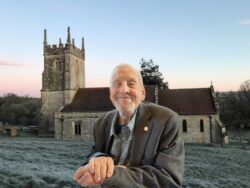Ray Nash had a ‘special connection’ with the village in Imber, Wiltshire (Picture: Kelvin Nash/SWNS)
A ‘ghost village’ evacuated in December 1943 is to host its last ever funeral.
Imber in Wiltshire is nestled within the Salisbury Plain, with meandering roads leading out to West Lavington and towards Tilshead.
It was once a bustling, albeit small, community complete with a school, church and even pub.
But the entire civilian population was evicted in 1943 to allow for American troops to train during the Second World War.
After the war, villagers were not allowed to return to their homes.
In the years since, the site has been used by the Ministry of Defence for training purposes.
But come January 5, a packed coach will trundle up the winding road to Imber – accompanied by an army escort.
It will carry around 100 well-wishers from the nearby town of Devizes, who will gather to say their final goodbyes to Ray Nash.
Ray Nash with his father, Jim, who died when Ray was one-year-old (Picture: Kelvin Nash)
Even after leaving Imber, the Nash family made yearly visits to their former home (Picture: Kelvin Nash)
Ray, a former mechanic for the Royal Electrical and Mechanical Engineers, left the village with his mum after his father Jim’s death in 1936.
He went on to visit the village every year that his son, Kelvin, can remember.
Kelvin told Metro.co.uk: ‘My dad will be buried next to his father Jim, it’s something he wanted for a long time.
‘Even though he left when he was young, he always had a connection to Imber.
‘We’d go back and meet relatives there – as a kid I remember I was more interested in exploring and looking at spent bullets. But next time I’m back, I’ll experience that emotional connection dad had.’
These days, Imber is only open to the public a few days a year. It is situated in the heart of the Army’s Salisbury Plain military training area.
To be buried there you need MoD permission and proof of living there.
Ray Nash had four children – Kelvin, David, Lawrence and Vicki, with his wife Elaine, who died two years ago (Picture: Kelvin Nash)
As he was christened in Imber, Ray was entitled to be buried there (Picture: Kelvin Nash)
While those visiting Imber today are met with the shells of former homes and echoes of the community that once was – a series of photos held by the Nash family give insight into what life might have been like.
One picture shows relatives on an annual visit to the ‘ghost village’, standing in the doorway of Ray’s mother’s home.
Today such a picture would be impossible to take, as the buildings are not accessible by the public on safety grounds.
Kelvin expects his dad will be one of, if not the last person to be buried in the village.
It’s unlikely any other residents are still alive eighty years after the evacuation.
Kelvin, a town councillor in Devizes, added: ‘The church in the village was the Church of St Giles, so every year on St Giles day, September 1, we would go and visit the church and village which would be open to the public.
St Giles’ church looms large over the long-abandoned village (Picture: Kelvin Nash)
Ray Nash, Elaine Nash, Kelvin Nash, Pam Nash by the grave of their Imber relatives (Picture: Kelvin Nash)
‘My great uncle Albert was the village blacksmith and was evacuated from the village in 1943 – he died in 1944 of a broken heart according to his death certificate, so it was a difficult thing for the family.
‘Quite a lot of relatives would do similar things, but it was quite a small village. I think the last funeral was about ten years ago now, so as time has moved on he may be the last person to ever be buried there.
‘The nice thing is that since his death we have even re-discovered a third cousin of mine who contacted me to come to the funeral – she only lives five miles from the village.
‘The process of arranging the funeral was much easier than I imagined. There is a man who has volunteered for 17 years to look after the village who has connections with the MoD who sorted everything for us.
‘On the day we will have to be escorted by the army into the village, so we’re taking all the 100 or so funeral attendees by coach from Devizes.
The homes in Imber are closed to the public due to health and safety guidelines (Picture: Kirsten Robertson)
Stories of a once-bustling community are passed on through generations (Picture: Kirsten Robertson)
‘I went over there a week ago to check his father’s grave, it was 7am and -6 degrees, but there was a completely clear sky and the sun was just coming up. It was really really tranquil, there was no other human within a five mile radius.
‘It sort of made me think about what life must have been like for farmers living in the village in the 1920’s and 1930’s and how harsh life must have been.’
The funeral for Ray Nash will take place at St Giles Church, Imber, on Thursday January 5.
To find out more about Imber, click here.
Get in touch with our news team by emailing us at [email protected].
For more stories like this, check our news page.
The entire civilian population was evicted in 1943 to allow for American troops to train during the Second World War.





